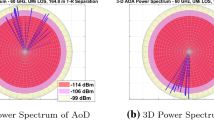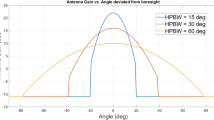Abstract
In dense traffic areas, wireless local area networks (WLANs) suffer from interference problems due to the usage of the crowded unlicensed ISM band and the lack of available spectrum. To mitigate these problems, a terminal side beamforming framework is proposed—this beamforming is capable of focusing the transmission and the reception in the relevant direction of the access point to exploit the directivity of the indoor propagation channel. It provides network transparency to achieve the backwards compatibility to the existing WLAN networks, and vendor transparency to ease the system design process and thereby achieve low complexity and costs. The beamforming enabled terminal benefits in terms of capacity, energy efficiency, and security while it does not require any change on the network side costing network providers new investments. It will be an attractive value-added feature as well as low-cost solution for the future WLAN terminal design opening the door for WLAN terminal manufacturers to include the proposed solution into their product line. In this work, a WLAN terminal beamforming demonstrator has been developed to demonstrate the capacity enhancement in real environments. Signal to interference ratio (SIR) improvement as well as array gain were investigated by simulations with IEEE 802.11n cluster channel models and by experiments with the demonstrator in a typical office environment. The comparable results of simulations and experiments show significant array gain and SIR improvement. The significant capacity increase has been demonstrated in the experiments in both an interference free scenario and an interference limited scenario.
Similar content being viewed by others
References
Balanis C.A. (1997). Antenna theory analysis and design. Wiley, New York
Bellofiore S., Balanis C.A., Foutz J., Spanias A.S. (2002). Smart-antenna systems for mobile communication networks. Part 1. Overview and antenna design. IEEE Antennas and Propagation Magazine 44(3): 145–154
Carey, J. M. & Grunwald, D. (2004). Enhancing WLAN security with smart antennas: A physical layer response for information assurance. In Proceedings of the IEEE VTC, Vol. 1, pp. 318–320.
Casas, E., Tong, C., da Silva, M., Yin, H., & Choi, Y. -S. (2003). Beam diversity for indoor WLAN systems. In Proceedings of the IEEE VTC, Vol. 5, pp. 3141–3144.
Erceg, V. et al. (2004). TGn channel models. In Proceedings of the IEEE 802.11–03/940r4.
Ho, M. -J., Wang, J., Shelby, K., Haisch, H. (2003). IEEE 802.11g OFDM WLAN throughput performance. In Proceedings of the IEEE VTC, Vol. 4, pp. 2252–2256.
“Information technology—Telecommunications and information exchange between systems—Local and metropolitan area networks—Specific requirements-Part 11: Wireless LAN Medium Access Control (MAC) and Physical Layer (PHY) Specifications.” ANSI/IEEE Std 802.11, 1999 Edition (R2003), pp. i–513 (2003).
Kalis A., Antonakopoulos T. (2002). Direction finding in IEEE802.11 wireless networks. IEEE Transaction on Instrumentation Measurment 51(5): 940–948
Kalis A., Antonakopoulos T., Maklos V. (2000). A printed circuit switched array antenna for indoor communications. IEEE Transactions on Consumer Electronics 46(3): 531–538
Knudsen M.B., Pedersen G.F. (2002). Spherical outdoor to indoor power spectrum model at the mobile terminal. IEEE JSAC 20(6): 1156–1169
Lemmon, J. J. Radiation pattern analysis of a four-element linear Array. NTIA Technical Memorandum TM-05-426, Available at HTTP: http://www.its.bldrdoc.gov/pub/ntia-rpt/05-426/05-426.pdf.
Nasipuri, A., Ye, S., You, J., & Hiromoto, R. E. (2000). A MAC protocol for mobile ad hoc networks using directional antennas. In Proceedings of the IEEE WCNC, Vol. 3, pp. 1214–1219.
Natarajan A., Komijani A., Hajimiri A. (2005). A fully integrated 24-GHz phased-array transmitter in CMOS. IEEE Journal of Solid-State Circuits 40(12): 2502–2514
Okamoto G.T. (1999). Smart antenna system and wireless LANs. Kluwer, Dordrecht
Paramesh J., Bishop R., Soumyanath K., Allstot D.J. (2005). A four-antenna receiver in 90-nm CMOS for beamforming and spatial diversity. IEEE Journal of Solid-State Circuits 40(12): 2515–2524
Song C.T.P., Mak A., Wong B., George D., Murch R.D. (2005). Compact low cost dual polarized adaptive planar phased array for WLAN. IEEE Transactions on Antennas and Propagation 53(8): 2406–2416
Tobagi F.A., Kleinrock L. (1975). Packet switching in radio channels: The hidden terminal problem in carrier sensing multiple access and busy tone solution. IEEE Transaction on Communication 23(12): 1417–1433
Vaughan, R. G. (1998). Beam spacing for angle diversity. In Proceeding of the IEEE GLOBECOM, Vol. 2, pp. 928–933.
Xu, K., Gerla, M., & Bae, S. (2002). How effective is the IEEE 802.11 RTS/CTS handshake in ad hoc networks. In Proceeding IEEE GLOBECOM, Vol. 1, pp. 72–76.
Author information
Authors and Affiliations
Corresponding author
Rights and permissions
About this article
Cite this article
Lu, C., Fitzek, F.H.P. & Eggers, P.C.F. Capacity enhancement by terminal originated beamforming for wireless local area networks. Wireless Pers Commun 43, 573–587 (2007). https://doi.org/10.1007/s11277-007-9250-y
Received:
Accepted:
Published:
Issue Date:
DOI: https://doi.org/10.1007/s11277-007-9250-y




